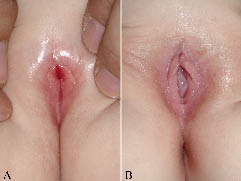The vagina is surrounded by two pairs of skin folds that look like lips, hence the name labia (Latin for “lips”). The outer pair is called the labia majora and inner pair the labia minora. Sometimes the labia minora stick together, narrowing or closing entirely the vaginal opening. This is called a labial adhesion. Most labial adhesions are so small — extending only a millimeter or two — that they go unnoticed by both parents and doctors.
The adhesions occur as a result of inflammation along the labia. The surface becomes sticky, and a small scar forms. Labial adhesions can appear anytime throughout the infant or toddler years, and most disappear on their own over time. The adhesions are sensitive to hormones, and they actually resolve in the pres¬ence of estrogen. This is why most adhesions go away during puberty if they haven’t disappeared before then.
What can I do?
If you notice an adhesion, bring it to the attention of your doctor. There is very little you need to do on your own at home.
 When does my doctor need to be involved?
When does my doctor need to be involved?
Most labial adhesions do not require medical treatment. How¬ever, if the adhesion is large, covering most of the vaginal open¬ing, there is a slightly increased risk of bleeding or infection, especially urinary tract infection (UTI). You should call your doctor if you notice redness or bleeding in the area or if your daughter complains of pain with urination.
What tests need to be done, and what do the results mean?
No tests need to be done with labial adhesions. However, the presence of an adhesion can increase the risk of UTI. If a UTI is suspected — if your child is complaining of pain with urination or of the need to urinate frequently — her urine should be checked with a urinalysis and a urine culture.
What are the treatments?
Labial adhesions can be treated using an estrogen cream applied directly to the area. Hormones (namely estrogen) help to dissolve the adhesions quickly and easily. However, this treatment pro¬vides only a short-term solution. Once the cream is no longer applied, the adhesion may return. If this happens, the cream can be repeated as needed. In general, estrogen creams are used only with an adhesion large enough to present a risk of infection.
What are the possible complications?
An adhesion can cause a UTI because it provides a place for urine to pool inside the vagina. Stagnant urine, like any other stagnant fluid, is more likely to breed infection than moving fluid. A UTI can cause fever, burning with urination, foul-smelling urine, and frequent urination.
Labial adhesions are known to recur even after several rounds of treatment with an estrogen cream. Repeated use of the cream can result in a change in the pigmentation (color) of part of the labia. Given the location of the tissue, the loss of pigmentation is generally not considered a significant side effect. In rare cases, the estrogen cream will stimulate the growth of hair around the vagina. When use of the cream is discontinued, the hair will go way.
